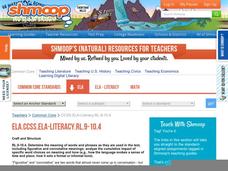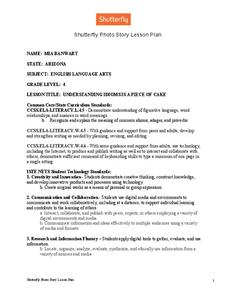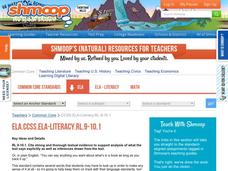Curated OER
Building Vocabulary
Decode and acquire new vocabulary! Readers use new vocabulary in their writing and use synonyms to determine meanings. Visual learners label pictures and group words together to increase understanding.
Curated OER
Using Color as a Pre-Writing Tool
To better understand how to compose a clear and well-organized paper, learners read short passages, write summaries, and make colored graphic organizers. This is a fully developed three-day lesson with suggested assessments.
Curated OER
Making Connection, Using Metaphor
Chief Seatle's "Letter to President Pierce, 1855" provides the text for a skills exercise that asks readers to consider how writers use metaphors to contribute to the meaning and impact of a work. Participants then apply what they have...
Curated OER
Simon Says: Mother May I?
Student increase their reading fluency through the use of various strategies. After discussing the importance of fluency, learners complete an initial read of a novel text. Working with the instructor, they read complete a timed...
Curated OER
Speedy Reader
Pupils practice the fluency of their reading by incorporating a variety of techniques and strategies. They read with stop watches and analyze "In the Big Top" and "Charlie," by Richard Vaughan. Students race and record their personal...
Curated OER
The Bottlenose Dolphin: Reading Comprehension
For this comprehension worksheet, students read a selection about the Bottlenose Dolphin, then answer 5 multiple choice questions. Answers provided.
Curated OER
The Lion and the Mouse: Reading Comprehension
For this comprehension worksheet, students read a selection about The Lion and the Mouse, then answer 5 multiple choice questions. Answers provided.
Curated OER
Alphabet Poems
Develop fluency with a variety of works. Help kindergartners use multiple strategies to understand text and decoding. They will create an alphabet poem book on Kid Works 2 to illustrate and write their own poem. In the end, they will...
Curated OER
Antonyms 3: Level 10
Identifying antonyms is one strategy for increasing vocabulary and is the focus of a 10 problem, multiple-choice learning exercise. In addition to the practice, learners will also benefit from a close reading of the provided answers and...
Core Task Project
Whatif by Shel Silverstein
What a skillful way to incorporate Shel Silverstein, a wonderful author, into the classroom. Composed of three tasks, children are led through a series of text-dependent questions that force them to unveil the meaning of Silverstein's...
Shmoop
ELA.CCSS.ELA-Literacy.RL.9-10.4
The fourth standard for reading literature in the Common Core calls for young readers to be able to determine the figurative and connotative meanings of words and phrases. Use this resource, a continuation of a series of Common Core...
Curated OER
Random Acts of Kindness For Kids
Develop a world-wide, email chain on which class members can showcase their acts of kindness. After defining the meaning of random acts of kindness through discussion and through a reading of Random Acts of Kindness,...
Curated OER
Joining Sentences
Sentence combining meets multiple objectives for writers, and they are all available in this informational text exercise. Learners read a mixed-up excerpt about the history of chess, putting 15 sentences into logical order. Have a...
Shutterfly
Photo Story Lesson Plan
After reading Loree Leedy's There's a Frog in My Throat: 440 Animal Sayings a Little Bird Told Me, kids create and illustrate their own poems that convey the meaning of an idiom. The poems are then transferred into Shutterfly's Photo...
Curated OER
Leveled Vocabulary for And Then There Were None
Chaotic, perjury, tenacious, vague, predatory, idiosyncrasy. Using Marzano and Brown’s six steps of direct instruction for vocabulary (choose, restate, illustrate, use, discuss, play) readers of And Then There Were None engage in a...
Shmoop
ELA.CCSS.ELA-Literacy.RL.9-10.1
Does your ELA class need some practice with the specific skills outlined in the Common Core standards? Then this is the perfect resource for you! One in a series of connected lessons that cover the standards for reading literature,...
Curated OER
Sneetches: Diversity of Learners
For Learners wanting to practice verbal/linguistic intelligence, any Dr. Seuss book is an excellent text for examining rhyming words. They explore words that rhyme with bully, mean, snooty, nasty, tease, harass, hurt.
Monterey Bay Aquarium
What's in a Name?
Combine art and word analysis in a lesson about genus and species. Elementary children sleuth out the meaning of scientific names for a number of shark species using a prefix and suffix definition chart. They then draw an image of the...
Teach-nology
Synonymn Password
Ten multiple choice questions make up a grammar learning exercise that lends its focus to synonyms. Young grammarians read each question and choose from four words that best make a synonym pair.
Museum of Tolerance
Essential Vocabulary and Concepts
Genocide. Scapegoat. Propaganda. Words are powerful. Words carry the weight of history. To prepare for a visit to The Museum of Tolerance, class members consider the weight of meaning in words related to intolerance.
Curated OER
Echinoderms
Echinoderm structure and characteristics are the focus of this reading comprehension and labeling worksheet. Attractive diagrams and ample information make this a suitable homework assignment for your biology buffs when learning about...
Curated OER
Proofreading: Lesson 2
Identify and develop strategies for proofreading with your class. They read and identify the grammar rules for capitalization, end punctuation, and commas, correct errors as a class, and complete three worksheets. This resource includes...
Education Development Center
Rational Exponents
It's rational to root for your class to learn about exponents. Scholars study rational exponents by reading a fictional dialogue between classmates. They analyze the conversation to understand the connection between rational exponents...
Curated OER
Oh, What A Day
Students listen as the teacher reads A Country Far Away. They predict what they will do and what they think their partner student will be doing. Students create a KWL chart for Japan. They collect information about their activities on an...

























